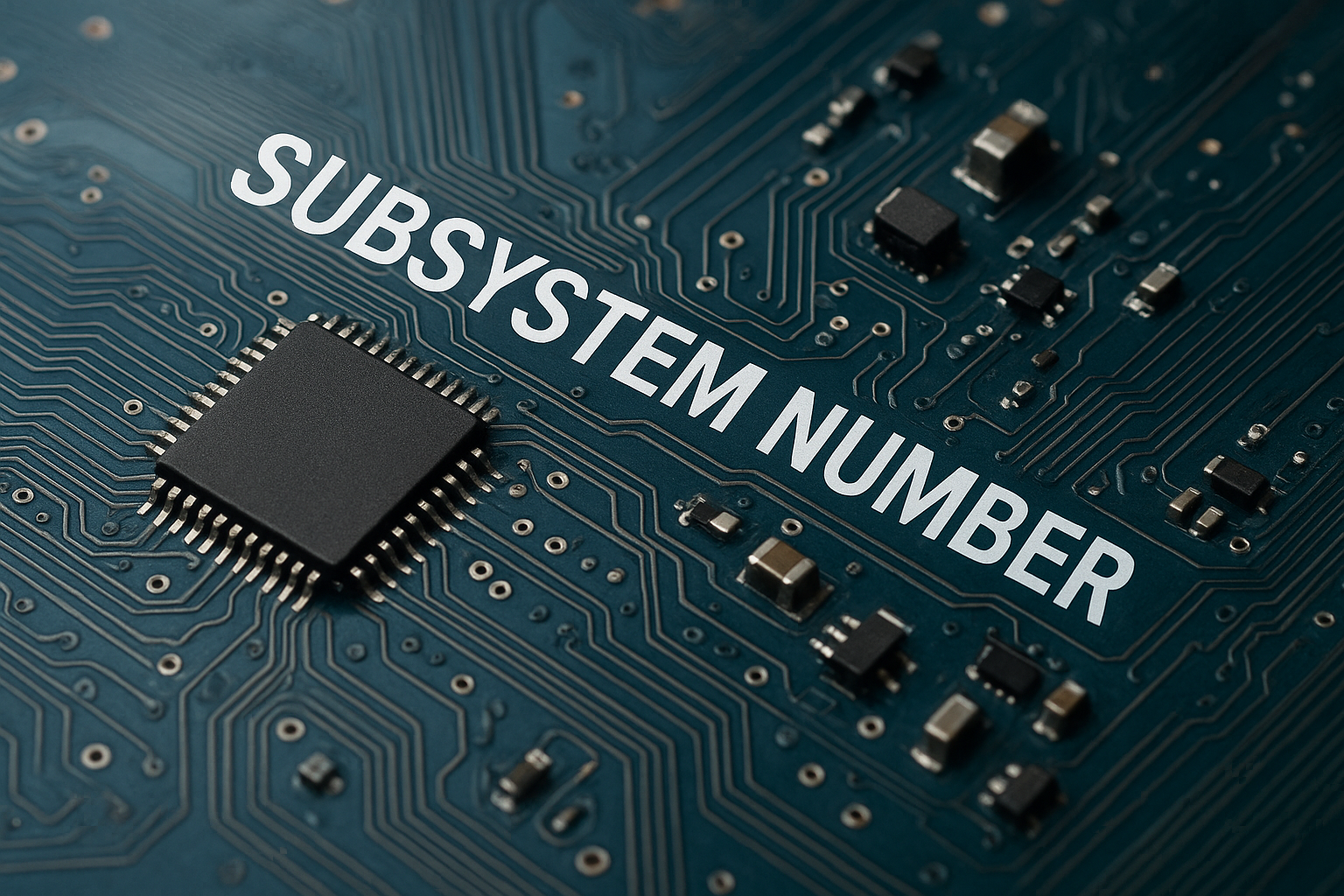A subsystem number may sound like something only engineers or IT professionals would ever use, yet it has a simple and practical meaning. In any large system—whether a car, computer, airplane, or software platform—there are smaller parts that work together to keep everything running smoothly. Each of these smaller units, known as subsystems, often needs its own identification number so that teams can track, document, and manage them accurately. This label is what we call a subsystem number.
Subsystem numbers exist to bring clarity and order to complex structures. Imagine a modern airplane that contains thousands of separate mechanical and electronic components. To avoid confusion, every major part is divided into subsystems—like the fuel system, navigation system, or landing gear—and each receives a unique number. This number acts like a digital fingerprint, connecting documentation, maintenance schedules, and design references.
In simple terms, subsystem numbers make large, complicated systems easier to understand. They break them down into smaller, traceable parts so that maintenance teams, engineers, and analysts can communicate clearly and stay organized.
Understanding the Concept of a Subsystem Number
At its core, a subsystem number is a structured identifier used to distinguish one part of a system from another. Its main purpose is organization. In technical environments—especially in engineering, manufacturing, and information technology—systems are rarely built as single units. They are made up of multiple interconnected components that perform distinct but related functions.
Without a clear numbering system, keeping track of these details becomes almost impossible. A subsystem number gives each component its own identity within a larger framework, allowing teams to quickly reference, update, or replace parts without confusion.
Subsystem numbers also provide clarity by showing how each smaller component fits into the overall design. In documentation or digital records, the numbering might even show relationships—like a tree structure—where each subsystem sits beneath a larger system and above smaller parts. This organized layering reduces human error, helps with audits, and improves system reliability.
How Subsystem Numbers Fit Into Larger Systems?
Every large system has layers. The main system represents the overall structure, while subsystems are the smaller units that make it functional. Each subsystem, in turn, may contain its own subcomponents, forming a hierarchy that flows downward. The subsystem number operates as a guide within this hierarchy, ensuring that anyone reviewing the structure can instantly identify what connects to what.
Consider a manufacturing plant where machines depend on electronic control systems. The master control system could be labeled “System 100,” while its subsystems—temperature control (Subsystem 101), motor control (Subsystem 102), and sensor feedback (Subsystem 103)—carry their own numbers. These subsystem numbers help engineers trace faults, schedule maintenance, or perform upgrades without mixing up parts or processes.
This hierarchical structure adds discipline to project management. By knowing which subsystem belongs to which larger system, project teams remain aligned, documents stay consistent, and any updates or modifications can be handled systematically.
Assigning and Managing Subsystem Numbers
Creating a good subsystem numbering system requires planning. There is no universal numbering format, but most organizations follow a consistent internal method. This might include sequential numbering, encoded identifiers that reflect function, or structured combinations of letters and numbers.
The key to an effective subsystem numbering strategy is consistency and traceability. Every subsystem number must link back to well-documented records showing what the subsystem does, who manages it, and how it connects to other parts of the system.
Proper documentation is critical. Each subsystem number becomes part of an ongoing chain of data—used in design documents, digital systems, maintenance logs, and reports. When managed carefully, this numbering framework allows both new and existing teams to quickly understand the layout of a system and identify its components precisely, even years after the design stage.
Applications Across Industries
Subsystem numbers may seem specific, but they have value in a wide range of industries. In engineering, subsystem numbers define mechanical assemblies and ensure that large projects—such as buildings, vehicles, or production lines—remain organized. Every major mechanical or electrical group has its own number for easy identification.
In software development, the idea translates into modular coding structures. Individual components or modules in a software architecture can effectively act as “subsystems.” Assigning logical numbers or codes to these modules helps developers manage dependencies and maintain quality control.
In manufacturing, subsystem numbers help track machine parts and workflow sections. Supply chain teams rely on these identifiers to coordinate production and maintenance schedules.
Meanwhile, in aerospace, subsystem numbers are essential for safety and precision. Airplane systems, for example, are divided into dozens of subsystems, each with its own reference code that corresponds to strict documentation and regulatory standards. This makes tracking and updates both efficient and compliant with safety regulations.
Across these fields, subsystem numbers simplify the complex. They allow different departments—engineering, operations, and management—to speak a common language.
Benefits of Using a Defined Subsystem Numbering Framework
A consistent subsystem numbering system provides several lasting benefits. The most obvious is better communication. When everyone uses the same numbering references, misunderstandings decrease dramatically. A maintenance engineer can refer to Subsystem 403, and colleagues immediately know the exact component in question.
Subsystem numbers also make troubleshooting and maintenance faster. Because every component is identified clearly, technicians can trace issues directly to the right subsystem without trial and error. This saves time, reduces downtime, and increases productivity.
Information organization is another advantage. In modern digital environments, systems often interface with databases and monitoring software. Subsystem numbers help connect physical assets and digital records seamlessly. This digital alignment supports automation, analysis, and system integration, creating a more connected and efficient operation.
Ultimately, the use of subsystem numbers reflects structured thinking. It ensures that no matter how complex a system becomes, it remains understandable, maintainable, and scalable.
Common Challenges in Subsystem Numbering
Even with the best intentions, subsystem numbering can become messy without proper control. One common issue is duplication—where two subsystems are accidentally assigned the same number. This often leads to confusion, wasted time, and possible system failures.
Another challenge is unclear documentation. If the meaning or hierarchy behind subsystem numbers isn’t well defined, new team members may misinterpret them. Over time, numbers could lose consistency, leading to weak traceability and poor version control.
A third issue arises when systems evolve but the numbering structure fails to adapt. As projects grow or enter new phases, subsystem numbers must be updated to reflect design changes or new functionality. Without periodic review, the numbering scheme may become outdated, reducing its usefulness.
To prevent these challenges, clarity and organization are critical from the start.
Best Practices for Creating a Reliable Subsystem Numbering System
Establishing an effective subsystem numbering approach begins with clear rules and documentation. Every number should follow a logical format that everyone understands, supported by detailed records explaining what each subsystem does.
Version control is equally important. Systems evolve, and so should their numbering. When new subsystems are added or old ones replaced, the numbering documentation must be updated immediately. This ensures alignment between the physical components and their digital or written records.
Collaboration is another cornerstone. Teams across design, operations, and maintenance must collectively review and refine the subsystem numbering approach. This teamwork prevents errors, promotes transparency, and ensures that the numbering structure remains intuitive for years to come.
Periodic reviews—ideally scheduled annually or alongside major updates—keep the entire system accurate and modern. A well-maintained subsystem numbering process becomes part of an organization’s knowledge base, supporting continuous learning and reliability.
The Evolving Role of Subsystem Numbers in Modern Systems
In today’s digital world, subsystem numbers are no longer just handwritten or static entries in spreadsheets. With automation, smart manufacturing, and digital twins rising, subsystem numbers now feed into sophisticated data ecosystems. Sensors, IoT devices, and management software all rely on consistent identifiers to exchange data in real time.
The role of subsystem numbers in digital integration also mirrors a broader shift in technology: the move toward context-rich, interconnected systems. As automation grows, these numbers ensure the integrity of data channels, supporting predictive maintenance, system updates, and traceable analytics.
Looking ahead, subsystem numbering will continue to evolve alongside AI-driven design and automated maintenance systems. What once was a simple identification method is steadily becoming a digital language for systems thinking—both in machines and across organizations managing them.
Conclusion: Why Subsystem Numbers Still Matter?
Despite being small pieces in enormous systems, subsystem numbers play a big role in keeping complexity under control. They provide structure where chaos could easily take over and allow people and machines to speak the same organized language.
Whether in engineering, manufacturing, software, or aerospace, subsystem numbers tie every part of a system together with logic and traceability. They support clear communication, simpler maintenance, and more efficient management.
In a world driven by data, digital transformation, and automation, subsystem numbers demonstrate the ongoing value of structured thinking. They remind us that even the most advanced systems depend on something simple: clear organization and consistency. That combination—clarity, efficiency, and structured order—is what keeps modern systems both functional and understandable.
My name is Mustafa, and I have been blogging for over 5 years. I am passionate about sharing complete, accurate, and helpful information with my readers. Along with managing content on The Matcha Read, I also contribute blog posts to premium websites. My goal is to provide valuable insights in a clear and easy-to-understand way, so every reader walks away with useful knowledge.










